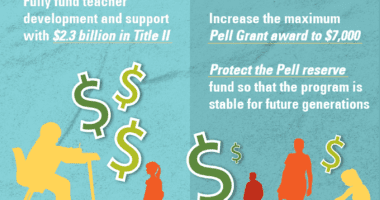ESSA: Just a Big Present to Adult Interests? Think Again!
This op-ed first appeared at The Hechinger Report.
President Obama just signed a new version of the nation’s main K-12 education law, passed by overwhelming bipartisan majorities in both chambers of Congress.
From news accounts, it would be all-too-easy to conclude that the Every Student Succeeds Act (ESSA) is simply an early Christmas present to adult interests and a big step backward in the fight for educational justice for kids — especially the low-income students, students of color, English learners, and students with disabilities who are the main focus of federal involvement in education.
Thankfully, this view is wrong.
Let’s be clear: ESSA isn’t a perfect bill. Far from it. But it does include serious protections for vulnerable students. And it creates important leverage for parents, communities, and advocates to continue their push for equity and accountability for all students. These protections include:
- Consistent, state-adopted standards for children that are aligned with the demands of postsecondary education and work. Standards are shared expectations for what all students should know and be able to do, and the newly required link to postsecondary education will prompt schools to prepare all students — not just the privileged few — for postsecondary study.
- Statewide annual assessment aligned with statewide standards. Statewide assessments ensure a common way of measuring student progress across classrooms, schools, and districts — which is one of the reasons that some educator groups tried to kill this requirement. But civil rights, disabilities, and business organizations fought hard to keep this requirement in place because annual assessments are vital for knowing which students need more help, and whether schools and systems are getting better at educating all students.
- Richer public reporting on academic outcomes and opportunities to learn for all groups of students, including, for the first time, school-level per pupil spending and access to rigorous coursework. Information on how all groups of students are performing academically, and whether all groups of students have access to key resources for learning, is a key tool for parents making important decisions for their children, as well as for parents and community groups working to spark necessary improvements.
- Clear requirements that statewide accountability systems must expect more progress from the groups of students who have been behind, base school ratings on the progress of all groups of students, and expect action when any group of students is consistently underperforming. Done right, these systems will create a clear expectation that schools make progress with all groups of students, not just some; help focus attention and resources on the full range of student groups; and ensure that when any group is struggling, schools and school systems can’t simply sit by and watch — they have to act.
- A demand that states and districts report on and address inequities in the rates at which low-income students and students of color are assigned to ineffective, out-of-field, and inexperienced teachers. This can help turn around one of the most damaging patterns in our schools: the tendency to assign vulnerable students to teachers who are not equipped to support them. The addition of “ineffective” is particularly critical to making certain that these efforts focus on quality, rather than only on the proxies for quality that were contained in previous law.
- Continued targeting of federal dollars to the highest poverty schools and districts. Though efforts were made to gut the provisions of previous laws that guarantee priority for the schools serving the biggest concentrations of poor children, these failed. Federal dollars will continue to flow, first and foremost, to schools facing the steepest climb to getting all students to high standards.
None of these provisions will guarantee gap closing and improved achievement for all. No law, no matter how strong, could ever do that.
But taken together, the provisions represent key building blocks for an equity-focused school system — one that sets high expectations for all students, provides resources necessary for meeting those expectations, measures and reports progress toward them, and ensures action when any group of students falls off-track.
So rather than succumbing to the naysayers and the chatterers, we’ll be working alongside equity advocates from all corners — from classrooms to statehouses, community centers to boardrooms — to take these blocks and together build the schools and systems all students need and deserve.
Photo credit: Evan Vucci, Associated Press












